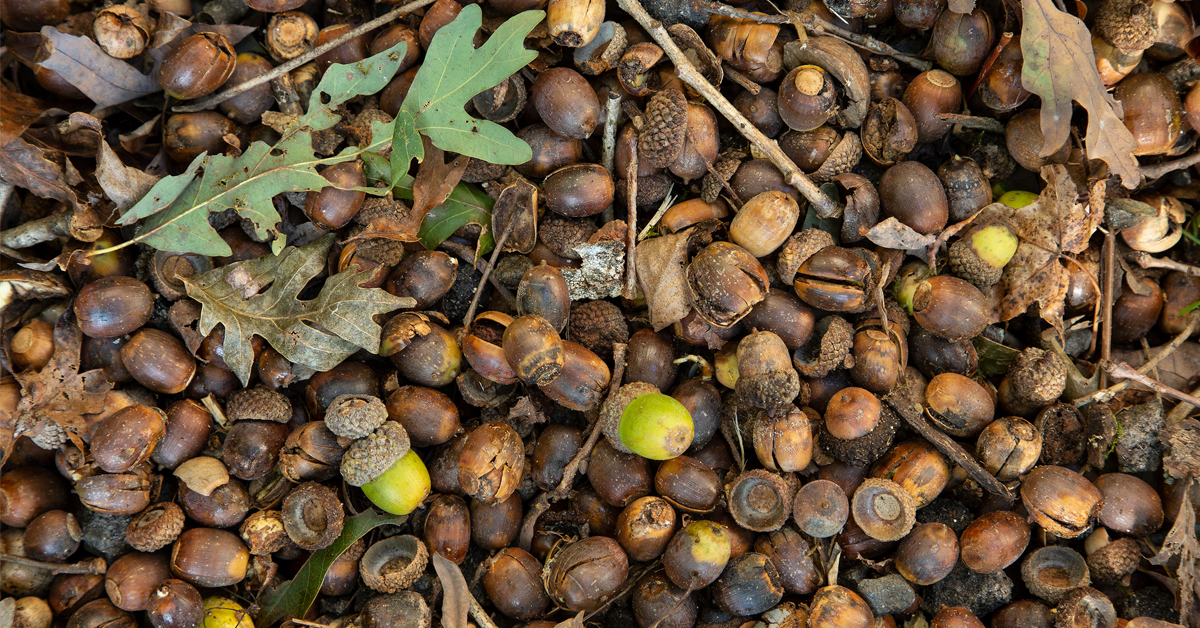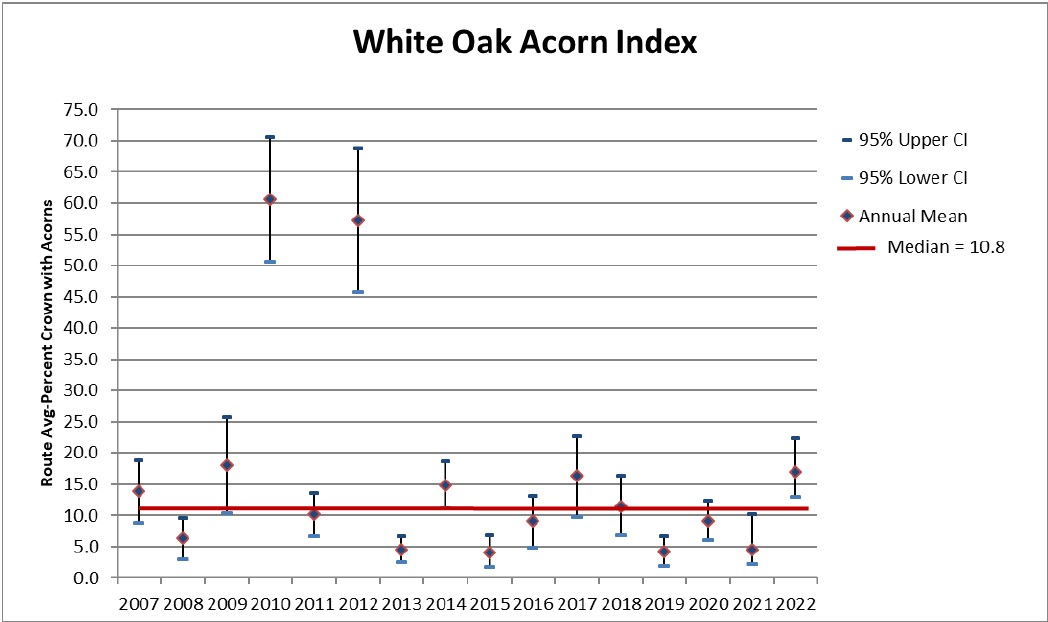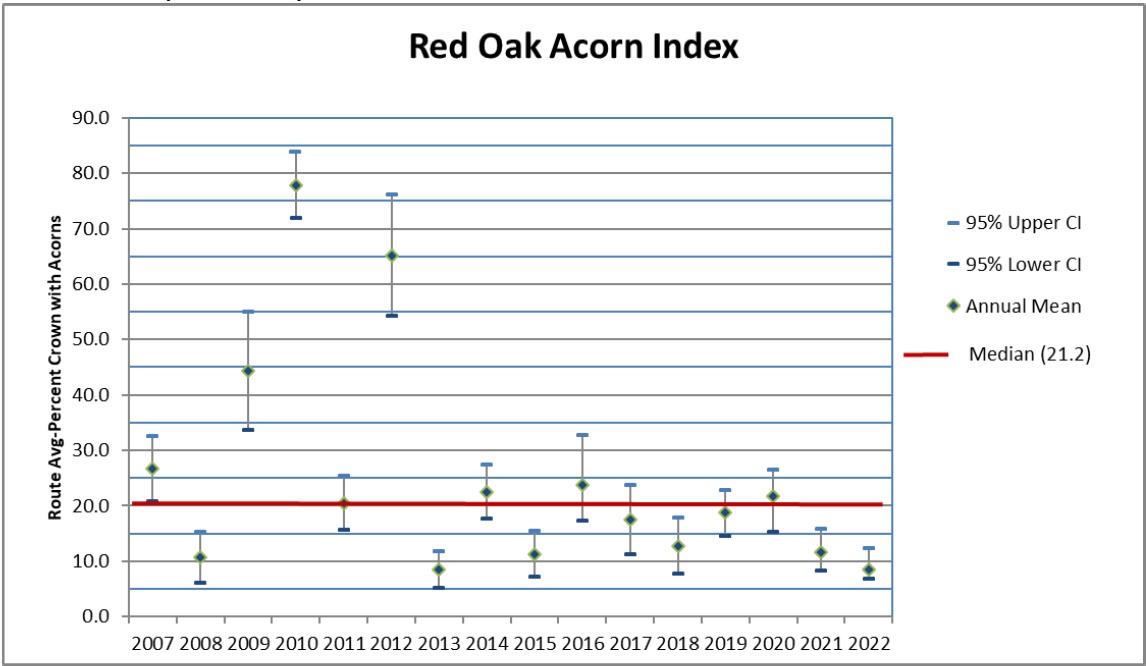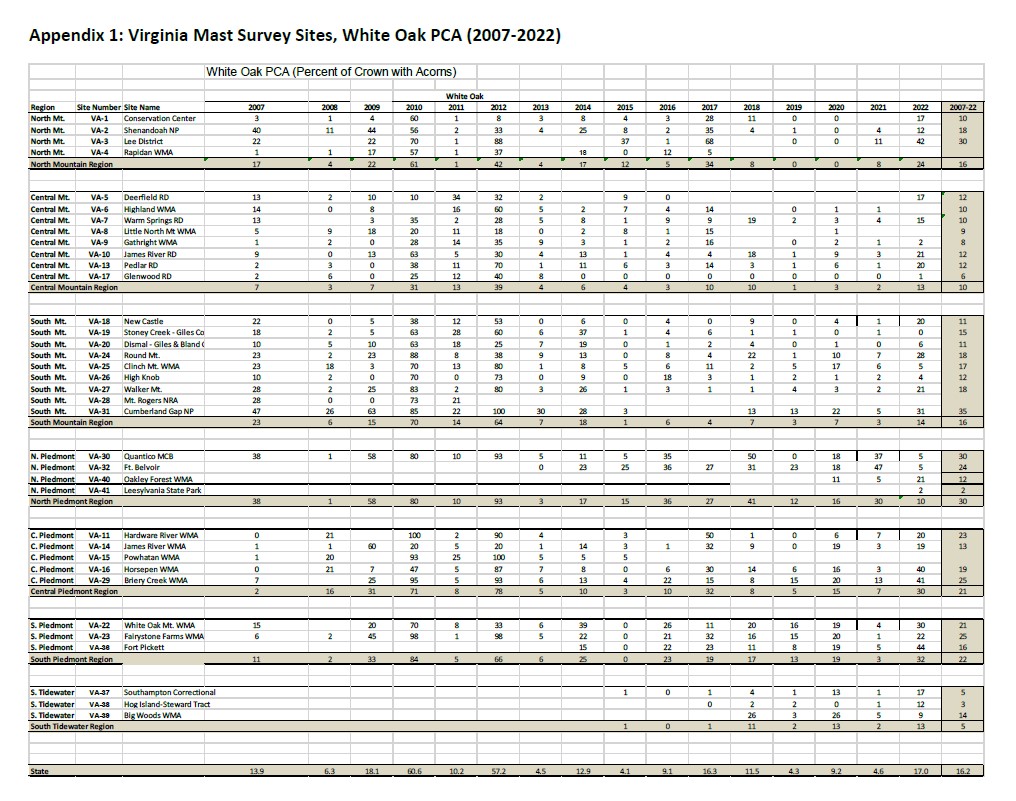2022 Acorn Production Report: Mixed Results

By Katie Martin/DWR Deer-Bear-Turkey Biologist
Acorn production across the state in 2022 can be categorized overall as average to above average for white oak and below average to poor for red oak species. Based on the annual hard mast survey, white oak routes came in above the long term survey average for the first time in four years, while red oaks stayed below average for the second year in a row.
As with all years, acorn production is highly variable and very site-dependent. Many routes had areas of “bumper” mast production even if their overall site average was below average. Red oak was generally poor across all sites and elevations this year with very limited pockets of average production. Conversely, white oak production was above average primarily in the Piedmont region and in lower elevations of mountain routes.
While acorn production is variable from year to year for many reasons (weather, insects, tree species), for some of our survey sites we are probably approaching the biological end of production due to tree age. Unfortunately, finding “new” stands of mature oak in the 50-70 year age range is becoming more and more difficult due to aging forests and lack of sufficient regeneration. Replacing aging trees/survey sites could be quite a challenge moving forward.
The annual hard mast survey has been an ongoing effort between the Virginia Department of Wildlife Resources (DWR) and many partner agencies for many years. Many of the mountain survey sites have been in place since the 1950s. In 2022, staff from DWR, the U.S. Forest Service, U.S. Fish and Wildlife Service, the Virginia Department of Conservation and Recreation-State Parks, Virginia Department of Forestry, U.S. Department of Defense/Department of Military Affairs, National Park Service, and Smithsonian Conservation Biology Institute surveyed 31 hard mast production sites across Virginia. Sites are located across all regions of the state, although a majority are currently found in the mountains. Continued efforts are being made to add sites to the Northern Piedmont and Tidewater areas.
Production by Region: White Oak
- Mountains: White oak production across most of the mountain region (17 survey sites) was above average. The North Mountain region averaged well above the long term median with excellent production found at several sites, across all elevations. The southern and central mountain routes had pockets of above average production and overall came in just above the long term average. Oak regeneration is a serious conservation issue in all of these areas and ongoing habitat management efforts have been underway by DWR and partner agencies to enhance areas with significant oak decline.
- Piedmont: White oak production across the Piedmont (11 sites) varied, but was highest in the Central and Southern Piedmont with an average PCA (percent crowns with acorns) of 32% and 30% respectively (well above the long term median of 10.8%). The northern Piedmont was just shy of the long term median at 10%. Anecdotal reports of “bumper” white oak trees have been received from throughout the Piedmont region this fall. These may be worth looking into, especially during the archery season!
- Tidewater: The Tidewater area has our lowest sample size with 3 sites. In 2022, 2 out of the 3 sites came in above the long term median (17% and 12%) while one site fell just shy (9%). This was a significant rebound though over the extremely poor productivity in 2021 (2% PCA). With low sample numbers it’s hard to make any hard and fast conclusions about acorn production in this area, but anecdotal reports of sites with good hard mast production have come in from this region throughout the late summer/early fall along with bumper crops of persimmons, crabapple, and other soft mast fruits.

Statewide white oak acorn production (average percent of tree crowns with acorns), presented as long term median (2007-2021) with 95% confidence intervals.

Statewide white oak acorn production (PCA) broken into categorical rankings based on 4 group cluster analysis with 95% confidence intervals.
Production by Region: Red Oak
- Mountains: Red oak production was sporadic across the mountain region with pockets of average production, particularly in the north and south mountain regions. The northern mountain region had the highest average of trees with positive acorn production, although all fell below the long term survey median (19.7%). Out of the 17 mountain sites, only one in the southern mountains came in above the median.
- Piedmont: Red oak production was below the long term median in all three Piedmont zones surveyed. Production across all sites trended lower than that found in the mountain region with very few reports of “bumper” crop trees. The Central Piedmont had the lowest average (7%) while the Northern and Southern Piedmont came in at 15% and 17% respectively.
- Tidewater: The Tidewater region averaged below the long term median, but did have 1 site with near average red oak production. The other Tidewater sites did report a few pockets of “good to fair” production in slightly drier soils.

Statewide red oak acorn production (average percent of tree crowns with acorns), presented as long term median (2007-2021) with 95% confidence intervals.

Statewide red oak acorn production (PCA) broken into categorical rankings based on 4 group cluster analysis with 95% confidence intervals.


Legal Disclaimer:
EIN Presswire provides this news content "as is" without warranty of any kind. We do not accept any responsibility or liability for the accuracy, content, images, videos, licenses, completeness, legality, or reliability of the information contained in this article. If you have any complaints or copyright issues related to this article, kindly contact the author above.
